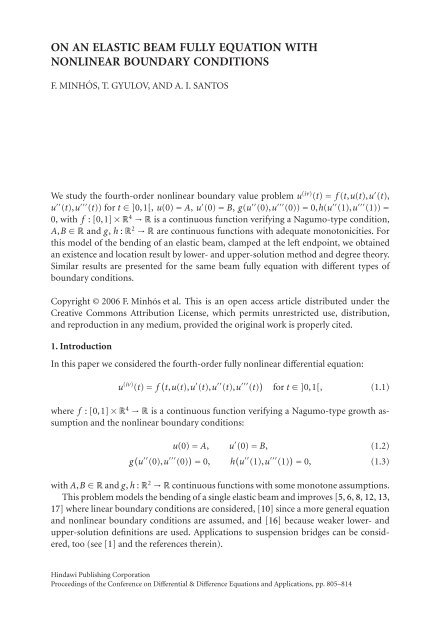DIFFERENtIAl & DIFFERENCE EqUAtIONS ANd APPlICAtIONS
DIFFERENtIAl & DIFFERENCE EqUAtIONS ANd APPlICAtIONS
DIFFERENtIAl & DIFFERENCE EqUAtIONS ANd APPlICAtIONS
You also want an ePaper? Increase the reach of your titles
YUMPU automatically turns print PDFs into web optimized ePapers that Google loves.
ON AN ELASTIC BEAM FULLY EQUATION WITH<br />
NONLINEAR BOUNDARY CONDITIONS<br />
F. MINHÓS, T. GYULOV, AND A. I. SANTOS<br />
We study the fourth-order nonlinear boundary value problem u (iv) (t) = f (t,u(t),u ′ (t),<br />
u ′′ (t),u ′′′ (t)) for t ∈ ]0,1[, u(0) = A, u ′ (0) = B, g(u ′′ (0),u ′′′ (0)) = 0,h(u ′′ (1),u ′′′ (1)) =<br />
0, with f : [0,1] × R 4 → R is a continuous function verifying a Nagumo-type condition,<br />
A,B ∈ R and g, h : R 2 → R are continuous functions with adequate monotonicities. For<br />
this model of the bending of an elastic beam, clamped at the left endpoint, we obtained<br />
an existence and location result by lower- and upper-solution method and degree theory.<br />
Similar results are presented for the same beam fully equation with different types of<br />
boundary conditions.<br />
Copyright © 2006 F. Minhós et al. This is an open access article distributed under the<br />
Creative Commons Attribution License, which permits unrestricted use, distribution,<br />
and reproduction in any medium, provided the original work is properly cited.<br />
1. Introduction<br />
In this paper we considered the fourth-order fully nonlinear differential equation:<br />
u (iv) (t) = f ( t,u(t),u ′ (t),u ′′ (t),u ′′′ (t) ) for t ∈ ]0,1[, (1.1)<br />
where f : [0,1] × R 4 → R is a continuous function verifying a Nagumo-type growth assumption<br />
and the nonlinear boundary conditions:<br />
u(0) = A, u ′ (0) = B, (1.2)<br />
g ( u ′′ (0),u ′′′ (0) ) = 0, h ( u ′′ (1),u ′′′ (1) ) = 0, (1.3)<br />
with A,B ∈ R and g, h : R 2 → R continuous functions with some monotone assumptions.<br />
This problem models the bending of a single elastic beam and improves [5, 6, 8, 12, 13,<br />
17] where linear boundary conditions are considered, [10] since a more general equation<br />
and nonlinear boundary conditions are assumed, and [16] because weaker lower- and<br />
upper-solution definitions are used. Applications to suspension bridges can be considered,<br />
too (see [1] and the references therein).<br />
Hindawi Publishing Corporation<br />
Proceedings of the Conference on Differential & Difference Equations and Applications, pp. 805–814

















